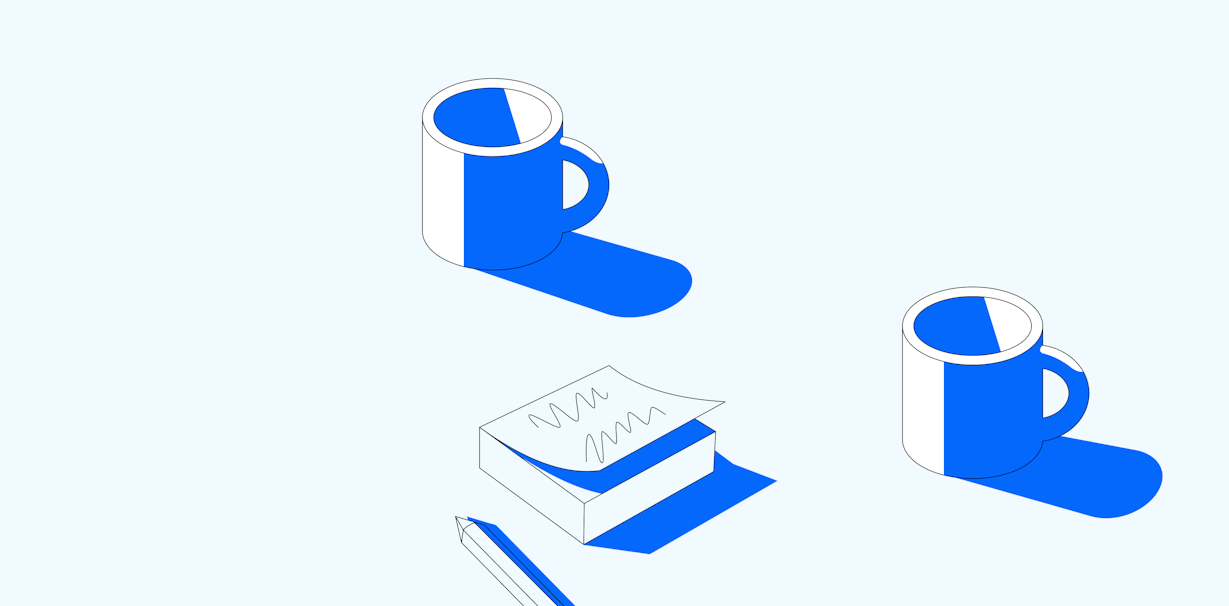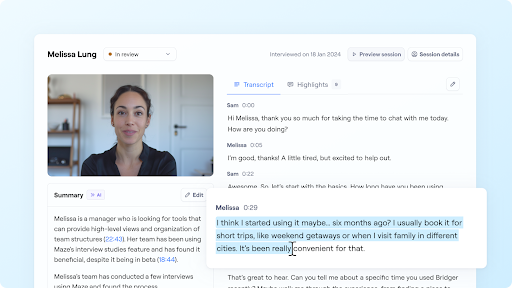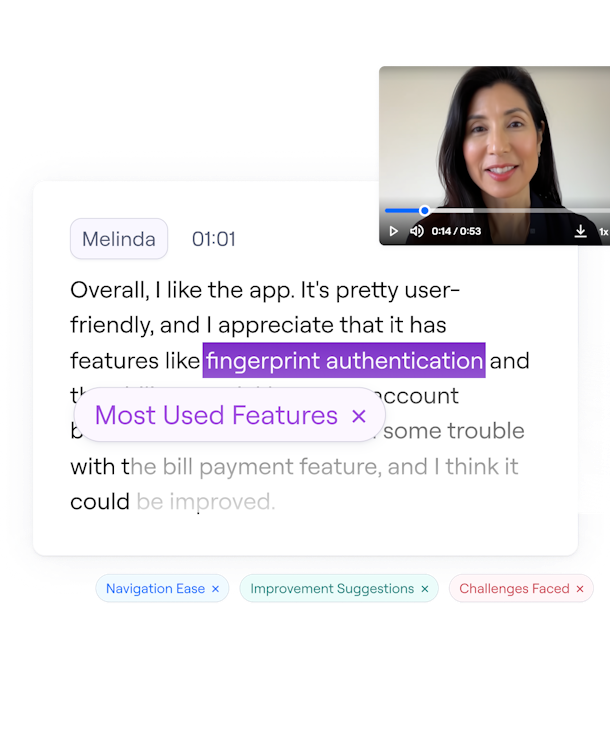
Unpacking Moderated User Interviews: Turning Conversations into Insights
User interviews are an effective moderated user research method for deeply understanding users and their experiences with your product. In this guide, we unpack everything from writing interview questions to conducting and analyzing your moderated sessions.
Chapter 1
An intro to user interviews: How talking to users informs product decisions
User-centric design is all about understanding your users’ perspectives, mental models, and expectations. But it’s not enough to know what your users think about your product; you need to uncover the why, too.
While fully understanding users may seem like a tall order—there’s an easy solution: sitting down with users and asking them questions questions face-to-face.
Whether you’re looking to get insights to inform your next big feature or fine-tune your final design, user interviews help you understand how your product can fit their needs.
In the first chapter of our comprehensive guide on user interviews, we’ll explain what user interviews are, why and when we use them, the different types at your disposal, and the pros and cons of adding interviews to your UX research arsenal.
Why are user interviews valuable?
User interviews are conversations between UX researchers and target users that explore the latter’s preferences, motivations, and behaviors related to your product. Interviews can be structured, unstructured, or semi-structured (more on that shortly).
This moderated, qualitative research method gives you rich insights for building user personas, creating journey maps, and designing the user experience.
User interviews are a critical part of the product development process:
- They help product managers understand and analyze how users think about your product and interact with it
- These conversations can validate or disprove hypotheses, helping design teams prioritize ideas and prevent wasted resources
- Interview data about specific product functionality can guide teams to iterate features and inform UX design decisions
- Firsthand user insights can align overall business decision-making with core customer needs
Haley Stracher, Design Director and CEO of Iris Design Collaborative explains the value of user interviews:
“Conducting user interviews can be validating and incredibly helpful in creating meaningful features to help your users solve their problems. Two-thirds of your budget will go into development, so user interviews are a great way to validate and test your ideas before spending that funding.”
So, what are your options? There’s more than one way to run user interviews—let’s look at the types of user interviews.
What are the types of user interviews?
User interviews vary in terms of structure, the type of insights they collect, and format. Let’s take a look at the different types of user interview, and when to use each.
Structured, semi-structured, and unstructured interviews
The structure of your interview greatly influences the flow and direction you’ll follow. Interviews can be:
- Structured: In structured interviews, you ask every participant the same set of pre-planned, open-ended questions. They allow you to hone in on specific topics while controlling the direction of the conversation.
- Unstructured: Unstructured interviews don't follow a planned script. Interviewees can steer the conversation, and researchers can take any route based on the responses they get.
- Semi-structured: Semi-structured interviews are a hybrid of the two models above, where researchers map out a basic plan for the conversation. They prepare a set of questions then ask relevant ones based on the interviewee’s responses.
Your interview structure is only one factor that influences the type of data you collect. You’ll also have to consider the type of data you want to collect.
Continuous, generative, and contextual interviews
Different interviews generate different types of data. The main types are:
- Continuous: Continuous interviews involve interviewing the same user over time to gather continuous data. This format maps the difference in users' thoughts. These open-ended interviews help in collecting ongoing insights for agile product development that keep user needs at the forefront of the process.
- Generative: Generative research aims to discover new insights about user behavior, challenges, and expectations. These exploratory interviews—that see you discuss topics with a wide variety of participants—are ideal for identifying pain points and defining the problem statement for further research.
- Contextual: Contextual interviews combine observation and interview to understand how different users behave in a specific environment or context. These interviews get answers to specific ‘how’ and ‘why’ questions by putting interviewees in a particular context.
💡 No matter what data you collect, you’ll need to analyze it. Find out how AI is transforming UX research and design, especially when it comes to data analysis.
In-person and remote interviews
Finally, your user interview format selection will depend on available resources, the number of users you want to interview, and the level of flexibility you need. You can run:
- In-person interviews: By putting the user and interviewer in the same room, in-person interviews help build empathy and establish rapport with interviewees. With in-person interviews, user body language and expressions can also provide more context and depth to the insights you collect.
- Remote interviews: This interview type takes place on a video call platform. Efficient, accessible, and flexible, remote interviews make it easier to talk to more users and increase the diversity of your participant base.
By considering each of these types of interviews and what best suits your needs, you’ll be able to conduct user interviews that get the valuable insights you’re after.
💡 Need to recruit participants to interview? Check out these seven tips for recruiting research participants, including using research participant recruitment solutions like Maze Panel to connect with your target demographic.
When should you conduct user interviews?
One of the best things about user interviews is their versatility. They’re a handy tool in your UX toolbox whenever you feel you’re lacking insight into your users' mental models or opinions.
Haley emphasizes it’s important to conduct user interviews from the get-go:
“You should conduct user interviews very early in your development process. I would suggest doing it as early as the design phase and before you’ve spent the money to develop the platform.”
Here are a few distinct activities within the design process when user interviews are especially useful.
Creating user personas
Without a foundational understanding of who you’re building a product for, you can’t get started with your design. User personas represent the different users within your audience, and include details on their wants, needs, attitudes, and behaviors.
You’ll frequently refer back to these personas to stay in touch with your target audience and inform product development.
User interviews help you get a deeper understanding of your users during the user persona creation process. You can use the information you gather to create evolved personas informed by insights, not guesswork.
Validating your design ideas and iterations
Before you begin designing and developing new products, features, or updates, it's crucial to ensure that your solution is actually what users are looking for. User interviews should be used alongside other research methods, such as usability testing, prototype testing, and content testing, to validate your idea against user needs.
Haley shares how she approaches validating design ideas by combining user interviews and prototype testing:
“I typically create a prototype and have people click through and answer questions at meaningful points in the app based on the user journey flows I create. So, a first user journey flow, for example, could be the registration and onboarding process. I create this flow and ask one–three meaningful questions at the end of the flow.”
By conducting user interviews, you’re able to get a deeper look at what users think about your proposed plans and ideas. You can gather qualitative insights from real users that will help ensure you build experiences, features, and products that meet real user needs.
Pre-launch and final product validation
If you’ve ever launched a new feature or product, you know just how critical the final design validation phase can be. It’s all hands on deck, with your whole team scrambling to find last-minute bugs, address user interface inconsistencies, and optimize every feature to meet user expectations. Incorporating moderated user interviews into your pre-launch process is a proactive step you can take to minimize potential oversights.
By directly engaging with users, you gather valuable feedback on where your design needs fine-tuning. This ensures your product is ready for launch, and the final design addresses the issues you set out to solve.
Making product and design iterations
One thing to keep in mind is that the product development process never ends. What may solve users' problems today, can quickly fail to meet evolving standards, leaving your product and design in the dust of today’s cutting-edge solutions.
This is an ideal time to conduct user interviews, but there’s never a bad time to connect with users. Your user research process should be continuous, and this involves regularly talking to users one-on-one.
So, what are your options? There’s more than one way to run user interviews—let’s look at the types of user interviews.
What are the pros and cons of conducting user interviews?
User interview pros | User interview cons |
|---|---|
They help you build relationships with users | They can be time-consuming |
They get deep, qualitative insights | They can get biased responses |
They offer flexible formats and types | They can be time-consuming to analyze |
They can be cost-effective | They depend on the interviewer’s skills |
Moderated user interviews are undoubtedly a useful and effective tool for collecting qualitative insights. But when are they the best choice for your next UX research project?
Here are some of the pros you’ll enjoy if you conduct user interviews:
- They help you build relationships with users: Interviews help you connect with users to build lasting customer relationships. This can help ensure your users feel heard while also encouraging them to join in future UX research projects to provide feedback.
- They get deep, qualitative insights: You can explore in-depth topics by asking open-ended and follow-up questions. This gives users ample opportunity to provide deeper responses and explain the root of their issues.
- They offer flexible formats and types: Not all interviews are alike. Because of the varied types, you can design your interview to best suit your UX research needs. For example, unstructured interviews allow for free-flowing conversations, providing the space for unexpected and contextual insights to emerge.
- They can be very cost-effective: Some interviews can be extremely cost-effective, such as those that are done remotely with users you’ve already connected with. Not all interviews require in-person interaction with freshly-recruited participants, it depends on your research goals (and budget)—interviews can provide an accessible way to conduct user research.
The rich, narrative feedback that user interviews uncover can help you make user-driven decisions across your organization. But, just like all UX research methods, they’re not the best tool for every UX research project:
- They can be time-consuming: While user interviews help for in-depth insights, they’re a moderated research method. It’s not uncommon for sessions to last upwards of 60 minutes, especially when unstructured. If you’re in a time crunch, you may be better off sending out UX surveys with open-ended questions.
- They can get biased responses: Observing your users while they answer interview questions may trigger types of cognitive bias like social desirability or the Hawthorne effect—study participants changing their behavior in response to their awareness of being observed. In user interviews, cognitive biases may lead to responses users wouldn’t usually give while unobserved.
- They can be difficult to analyze: Extracting actionable insights from qualitative data requires thematic analysis. Although effective, this analysis method can be a time-consuming and resource-intensive process if you don’t have access to a user interview analysis tool.
- They depend on the interviewer's skills: Interviewing is an art. Interviews are only insightful when interviewers can conduct them effectively, which depends on the interview questions and the interviewer’s skills.
User interviews vs. usability testing vs. surveys vs. focus groups
User interviews are just one of the many tools in a UX researcher’s toolbox. Here’s how user interviews compare to other popular UX research methods:
Method | Purpose | Approach | Strengths | Limitations | Best for |
|---|---|---|---|---|---|
Moderated user interviews | Gather in-depth insights into user experiences, motivations, and behaviors | Moderated, one-on-one conversations with open-ended questions | Deep understanding of user needs and emotions Flexible and adaptable to the conversation | Time consuming Opinions may not represent the whole user base | When you need to explore needs, motivations, and user experiences in depth |
Usability testing | Evaluate how users interact with and navigate a product to find usability issues | Observing users performing specific tasks on a product | Direct observation of real interactions Identifies actionable usability issues | Focused on usability rather than overall user insights Requires a working prototype | During design and development to improve UI/UX and test task flows |
Surveys | Collect data on user opinions, behaviors, and demographics at scale | Structured questionnaires are distributed to a large audience | Scalable and cost-effective Quantifiable results | Self-reported data may be biased | When seeking large-scale input or validating findings from qualitative research |
Focus groups | Explore user attitudes, beliefs, and reactions in a group setting | Moderated discussions with a small group of target users | Uncovers diverse opinions and group dynamics Generates new ideas | Groupthink can skew insights Dominant participants may overshadow others | Early in design to brainstorm ideas or explore collective attitudes and beliefs |
Moderated user interviews with Maze
Maze's comprehensive suite of research methods and features makes recruiting for, managing, conducting, and analyzing user interviews easy. Let’s take a look:
1. Recruit the right participants: Recruit from your own community or choose from over 3 million participants across 130 countries with the Maze Panel. Filter participants with 400+ screener questions and manual selection to refine your picks. Then manage all communications with Maze Reach–our CRM solution for research participants.
2. Schedule interviews in a matter of minutes: Integrations with Google Calendar and Office 365 make syncing availability a breeze. Automated email reminders and meeting buffer time helps streamline your day and reduce no-shows.
3. Conduct moderated interviews with integrated tools: With built-in video conferencing and integrations with Google Meet, Zoom, and Microsoft Teams, Maze's Interview Studies fits into your existing UX workflow and tech stack.
4. Speed up analysis with Maze AI: Let AI do the heavy lifting with your interview analysis: Maze AI can suggest key moments of interest from your interview recording, generate transcripts, and group highlights into themes to rapidly identify trends.
5. Share insights with stakeholders: Maze simplifies creating and sharing your UX research reports, with Automated Reporting to summarize themes and package up highlights into an easy-on-the-eyes, ready-to-share report.

Up next: How to conduct moderated user interviews
There’s a lot to consider when choosing a UX research method, and ultimately, whether you should run user interviews depends on your goals, resources, and capabilities.
When done right, moderated interviews are a flexible research method that can provide valuable, in-depth insights at all stages of product development. You can use interviews to inform other research initiatives, new feature development, and more.
In Chapter Two of this five-part guide, we’ll be looking at how to conduct user interviews and best practices to keep in mind. Read on for more.
Moderated research has never been so easy
Simplify your interview workflow from start to finish with automated scheduling, seamless video sessions, and Al-driven analysis and reporting.

Frequently asked questions about user interviews
How do you prepare for a user interview?
How do you prepare for a user interview?
Preparing for a user interview typically involves thinking of objectives, deciding on the format, and creating an interview guide. If you want to be thorough, then you should also prepare your chosen research tools for the process, such as video conferencing or note-taking solutions.
How long are user interviews?
How long are user interviews?
The length of user interviews can vary. They typically last between thirty minutes and an hour. However, this will depend on the complexity of the topics you’re discussing. It’s also essential to respect users’ time, avoiding rushing the conversion but also not drawing it out more than necessary.
How many user interviews should you do?
How many user interviews should you do?
The number of interviews you do will depend on your UX research goals and the diversity of your participant database. A rule of thumb is to conduct between five and ten interviews per user group to identify common patterns. However, you may need to conduct more to capture a wide range of perspectives, especially if your user base is diverse.


